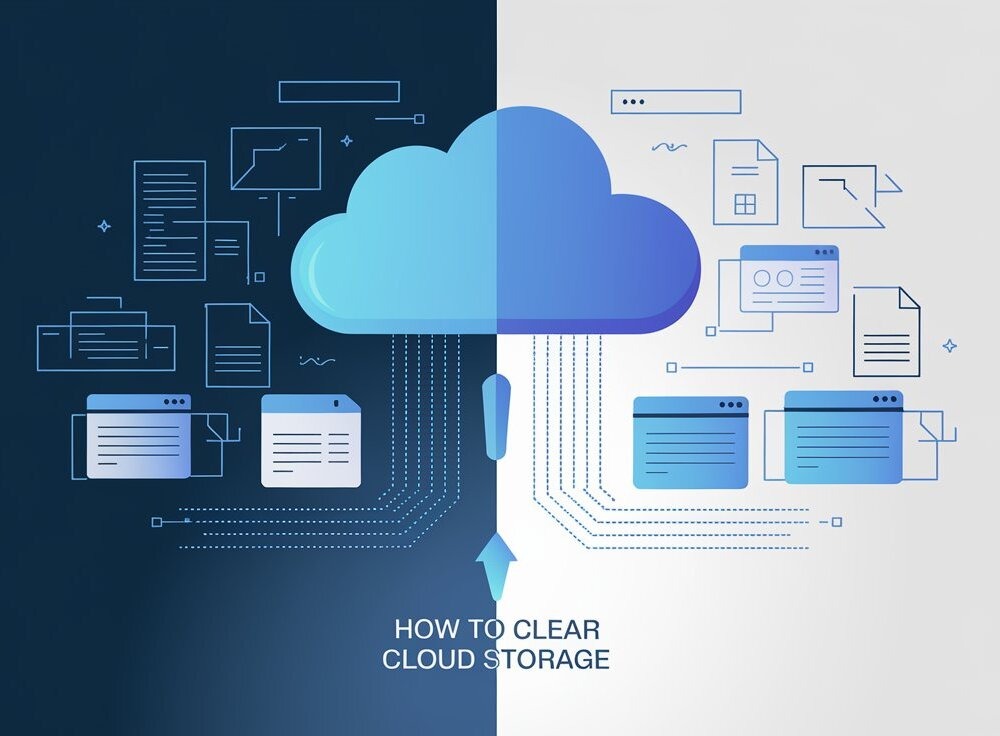Cloud storage has become an essential tool for many people in today’s digital world. Whether it’s for storing family photos, important documents, or work files, cloud storage services like Google Drive, iCloud, and OneDrive offer a convenient way to keep everything in one place. However, as we store more data, it’s easy for cloud storage to fill up quickly. How to clear cloud storage becomes a pressing question when your storage reaches its limits. In this post, we’ll discuss why your cloud storage may be full and give you 9 actionable tips on how to clear cloud storage effectively.
Table of Contents
Why Is My Cloud Storage Full?
Before we dive into how to clear cloud storage, it’s important to understand why your cloud storage might be full. There are several reasons that contribute to cloud storage overuse, including the accumulation of large files, app data, and backups. Here’s a breakdown of the most common reasons for your cloud storage getting full:

1. Accumulation of Photos and Videos
One of the biggest reasons cloud storage fills up is the sheer volume of photos and videos. How to clear cloud storage when photos and videos are taking up too much space? It’s simple: delete the ones that are no longer needed. Old videos and photos, especially high-resolution ones, can quickly consume all your storage space.
2. Unnecessary App Data
Many apps automatically sync their data with the cloud. This includes everything from chat history in messaging apps to synced files in productivity apps. How to clear cloud storage when app data becomes bloated? You need to manage and delete unnecessary app data from the cloud.
3. Outdated Documents and Files
You may have stored documents and files in your cloud that you no longer use. These files can take up valuable space without serving any purpose. To clear cloud storage, you’ll need to review and remove old files, PDFs, and documents that are not important anymore.
4. Excessive Backups
Cloud backups are a great feature, but they can fill up your storage without you realizing it. If you’ve backed up multiple devices to the cloud, this can quickly consume your available storage space. How to clear cloud storage from unnecessary backups? Check and remove old backups that you no longer need.
5. Shared Files
When you share files with others, they remain in your cloud storage until you remove them. These shared files can accumulate over time and take up space. How to clear cloud storage from shared files? Simply review and remove any files that were shared with others but are no longer necessary.
9 Ways to Fix It: How to Clear Cloud Storage
Now that we know why cloud storage gets full, let’s focus on how to clear cloud storage effectively. Below are 9 practical tips that will help you free up space and keep your cloud storage organized.

1. Delete Unnecessary Photos and Videos
The first and most obvious way to clear cloud storage is by deleting unnecessary photos and videos. This is usually the largest culprit when it comes to taking up space. How to clear cloud storage from photos and videos? Here’s what you can do:
- Remove duplicate photos and videos: Cloud services like Google Photos and iCloud often detect duplicates, which you can delete to save space.
- Delete old and irrelevant videos: If you have videos that you no longer watch or need, get rid of them to free up significant storage.
2. Clear App Data and Cache Files
Another important step in how to clear cloud storage is by managing app data and cache. Apps like WhatsApp, Facebook, and Instagram sync data to the cloud and can take up significant storage. How to clear cloud storage from app data? Simply:
- Clear cache regularly: Apps like Google Drive and WhatsApp store cache files, which can be safely deleted.
- Remove unused app data: If you have apps that you no longer use but their data still occupies cloud storage, delete the data.
3. Organize Your Documents and Files
Files and documents can also fill up your cloud storage quickly. To clear cloud storage, take the time to organize and remove unnecessary files.
- Delete outdated files: Go through your documents and remove those you no longer need, such as old reports, presentations, or PDFs.
- Move files to an external hard drive: If you don’t need immediate access to certain files, transfer them to an external drive to keep your cloud storage free.

4. Remove Old Device Backups
If you’ve backed up multiple devices to the cloud, you might find that your cloud storage is filled with old backups. How to clear cloud storage from backups? Here’s how you can manage backups:
- Delete backups of old devices: If you no longer use a device, remove its backup from your cloud storage.
- Disable automatic backups: Turn off automatic backups for devices that you no longer use, so they don’t continue to fill your cloud.
5. Unshare Files You No Longer Need
Shared files take up space in your cloud storage, so to clear cloud storage, review all shared files and remove those you no longer need.
- Remove unnecessary shared files: If a project is complete, remove the files you shared with others.
- Unshare files with others: If you no longer need a file shared with others, unshare it to clear space in your cloud storage.
6. Use Cloud Storage Management Tools
Most cloud services offer tools to help you manage storage. To effectively clear cloud storage, you can use these built-in features:
- Google Drive Storage Management: Google Drive allows you to check which files are taking up the most space, helping you easily delete large files or move them to another service.
- iCloud Manage Storage Feature: iCloud offers a similar tool to review the storage used by apps and files, helping you identify where to free up space.
7. Set Up Automatic Cleanup
To ensure that your cloud storage stays organized, set up automatic cleanup features where available. This will automatically remove old files and backups. How to clear cloud storage with automation?
- Enable automatic deletion for unused files: Set up your cloud service to automatically delete old files, backups, and other unused data.
- Use storage management alerts: Enable alerts from your cloud service when storage is near its limit, helping you stay proactive about cleaning up.

8. Consider Cloud Storage Alternatives
If your primary cloud service is full, consider using other platforms to spread out your data. This will help you avoid running out of space quickly. How to clear cloud storage from one platform? Try diversifying your storage options:
- Use multiple cloud services: Store documents on Google Drive, photos on iCloud, and backups on Amazon Drive, for example.
- Use external storage for backups: Consider using external hard drives for backups instead of relying solely on cloud storage.
9. Upgrade Your Cloud Storage Plan
If you’ve tried everything to clear cloud storage but still need more space, upgrading your storage plan might be the best solution. Most cloud services offer reasonably priced plans for additional storage, and this option can save you time and hassle.
- Upgrade your cloud storage plan: If you need more space, upgrading to a larger storage plan is often an affordable solution.
- Look for bundled offers: Many cloud services offer discounts for purchasing larger plans on an annual basis.
The Importance of Cloud Storage Management
Cloud storage is an essential part of our digital lives, but many users overlook the importance of managing it properly. Keeping your cloud storage organized not only helps you free up space but also ensures your files are easy to access when you need them. Here’s why how to clear cloud storage matters:
- Improved Efficiency: When you have a clean and organized cloud, it’s easier to find what you need quickly. You won’t waste time sifting through a cluttered storage system.
- Better Security: By periodically reviewing your cloud storage, you can remove outdated or redundant files that could compromise the security of your sensitive data.
- Cost Savings: Regularly clearing out unnecessary files can help you avoid upgrading to a larger storage plan unnecessarily.
By taking a few steps to clear cloud storage, you’ll be better equipped to handle your growing digital needs while ensuring everything stays in order.
Tips for Preventing Cloud Storage from Filling Up Again
Now that you know how to clear cloud storage, it’s important to adopt some habits that will help you avoid filling it up again. Here are a few tips to maintain a manageable cloud storage space:
- Regularly back up and clean: Set a reminder every few months to check your cloud storage and remove outdated or unused files.
- Use cloud storage wisely: Instead of uploading everything to the cloud, consider keeping only critical files in the cloud and storing larger files on external drives.
- Compress files before uploading: For large files, such as videos, consider compressing them before uploading to save space.
- Enable cloud service notifications: Many cloud services send notifications when you’re nearing your storage limit. Set these up so you’re alerted before space becomes an issue.
If you’re looking for more ways to optimize your cloud storage experience, check out The 10 Best Features of True Cloud for PC That Will Blow Your Mind for game-changing tips on maximizing cloud potential for your PC.
Conclusion
Now that you know how to clear cloud storage, you can start managing your digital data more efficiently. By regularly cleaning up old files, clearing app data, and using cloud storage management tools, you can keep your cloud organized and free from unnecessary clutter. Whether it’s removing old photos, deleting app cache, or upgrading your storage plan, you now have several methods at your disposal to manage your cloud storage effectively.
If you want to prevent your cloud storage from filling up again, make it a habit to periodically review and clear out old data. With these tips on how to clear cloud storage, you’ll be able to maximize your available space and keep everything organized.
Have you tried any of these tips? Let us know in the comments how you manage your cloud storage and if there’s anything else you do to keep it from filling up.
FAQs on How to Clear Cloud Storage
1. How do I check which files are using the most cloud storage?
Most cloud services provide a storage management feature that lets you view what’s taking up space. For example:
- Google Drive: Use the “Storage” section to see the largest files.
- iCloud: Go to “Manage Storage” to see data usage by apps and backups.
- OneDrive: View storage usage under “Settings” and see a breakdown by file types.
These tools help you identify large files, backups, and other data consuming your storage.
2. Can I recover files that I’ve deleted from my cloud storage?
Yes, most cloud services have a “trash” or “recycle bin” feature where deleted files are stored temporarily before being permanently erased. You can recover these files by visiting the trash/recycle bin and restoring them. However, once the file is permanently deleted, recovery is often not possible unless you have a backup.
3. What should I do if my cloud storage is full and I need more space?
If your cloud storage is full, you have a few options:
- Delete unnecessary files: Remove old documents, photos, videos, or backups that you don’t need.
- Upgrade your storage plan: Many cloud providers offer affordable plans to increase your storage.
- Move files to external storage: Transfer files to a local hard drive or external storage device to free up space.
4. How often should I clean up my cloud storage?
It’s a good practice to clean your cloud storage at least once every few months. Regularly checking your files ensures that you don’t accumulate unnecessary data, preventing your cloud storage from filling up unexpectedly. Setting reminders can help you stay on top of this task.
5. Why do I have multiple backups in my cloud storage?
Multiple backups are created when you have several devices synced to your cloud storage. Each device (phone, tablet, computer) might have its own backup, consuming a significant amount of storage space. To clear cloud storage, you should remove backups of old or unused devices and disable automatic backups for devices you no longer use.








